-
Countries
-
Data and Analysis
-
Special Focus
-
Crisis Responses
Assessment Report

Contact
DTM DRC, iomdrcdtm@iom.int
Language
English
Location
Democratic Republic of the Congo
Period Covered
Aug 03 2023
Sep 12 2023
Activity
- Mobility Tracking
- Baseline Assessment
IOM DRC - through its Displacement Tracking Matrix (DTM) - has been conducting Mobility Tracking (MT) assessments since 2018. These exercises are implemented in the DRC with the aim of providing estimates on presence, number of affected population groups (IDPs, returnees), reasons for displacement, duration of displacement and specific needs within defined locations. Data for the MT exercise is collected on a bi-annual basis by teams of trained enumerators, through key informant interviews and direct observations at a village level. As part of this process, IOM ensures the participation of government representatives during data collection to promote and build capacity in the event of handover. IOM data is then presented to and validated by the provincial Population Movement Commission (Commission de mouvement de population – CMP in French).
The summary statistics presented in this report are drawn from the most recent MT round for each province, which took place between August and September 2023, to produce an overview of the displacement situation in the Eastern DRC region.
In the four eastern provinces of the DRC, comprising Ituri, North-Kivu, South Kivu, and Tanganyika, during this assessment DTM identified 5,637,536 internally displaced people (IDPs) and 4,324,523 returnees, present in 76 per cent of assessed villages. DTM estimates that the highest proportion (41%) of IDPs (2,300,163 individuals) are hosted in North Kivu, followed by 29 per cent (1,630,535) in Ituri, 24 per cent (1,356,376) in South Kivu and 6 per cent (350,462) in Tanganyika. The most frequently reported reasons for displacement among displaced populations living in host families are attacks by armed groups (84%), inter-community conflict (12%) and natural disasters (3%). An estimated 908,920 individuals were displaced by the M23 crisis at the time of the most recently produced DTM crisis analysis.

Contact
dtmlebanon@iom.int
Language
English
Location
Lebanon
Period Covered
Oct 10 2023
Nov 07 2023
Activity
- Mobility Tracking
- Baseline Assessment
Since October 8 there has been an increase in cross-border incidents between Israel and Lebanon, resulting in the displacement of people both within the South and elsewhere within the country. Since October 10, the Displacement Tracking Matrix (DTM) has been conducting the daily monitoring of population movements. The objective of the exercise is to inform preparedness and response planning.

Contact
DTMUkraine@iom.int
Language
English
Location
Ukraine
Snapshot Date
Sep 30 2023
Activity
- Baseline Assessment
Базова територіальна оцінка зареєстрованих ВПО надає детальні дані щодо кількості та географічного розташування офіційно зареєстрованих внутрішньо переміщених осіб (ВПО). У звіті оцінено присутність зареєстрованих ВПО на рівні районів, а також відображено на мапі зафіксовані зміни, що відбулися з попереднього раунду. У раунді 28 представлені дані щодо кількості зареєстрованих ВПО із розподілом за статтю, віком та визнаним державою статусом особи з інвалідністю.
Дані, зібрані для раунду 28 Базової територіальної оцінки, відображають актуальні цифри місцевого адміністративного реєстру ВПО станом на 30 вересня 2023 року, що складає 3 516 338 зареєстрованих ВПО.
Дані про кількість зареєстрованих ВПО було зібрано щодо 1 039 громад (78% усіх охоплених громад на підконтрольних українському уряду територіях). Дані з розподілом за віком, статтю та статусом особи з інвалідністю було надано щодо приблизно 76% охоплених адміністративно-територіальних одиниць.
Для цілей цієї оцінки МОМ визначає ВПО як осіб, що залишили своє звичне місце проживання через нинішню війну в Україні і офіційно зареєструвалися як ВПО в місцевих органах влади.
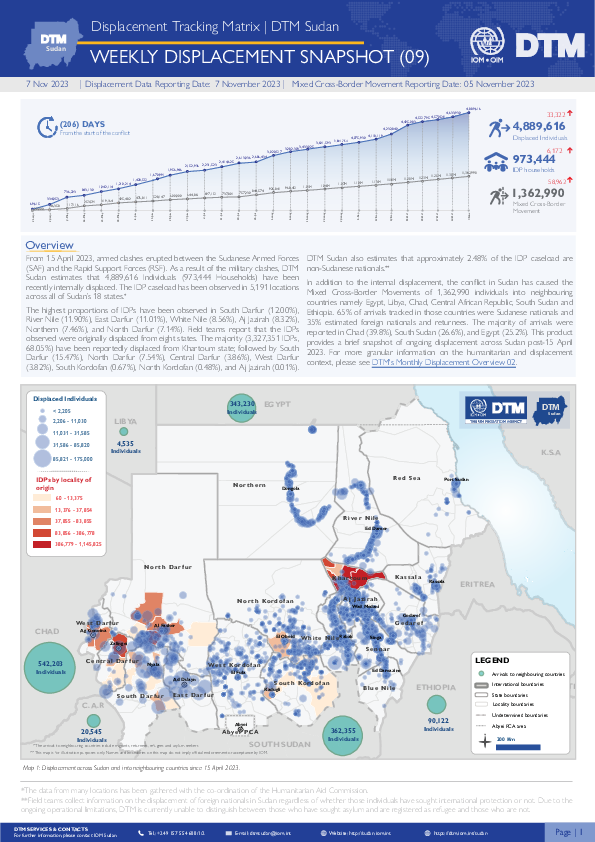
Contact
DTM Sudan, SudanDTM@iom.int
Language
English
Location
Sudan
Snapshot Date
Nov 01 2023
Activity
- Mobility Tracking
- Baseline Assessment
Overview
From 15 April 2023, armed clashes erupted between the Sudanese Armed Forces (SAF) and the Rapid Support Forces (RSF) in multiple cities across Sudan. Clashes initially took place in cities across Northern and Khartoum states, later spreading across the Darfur and Kordofan regions.
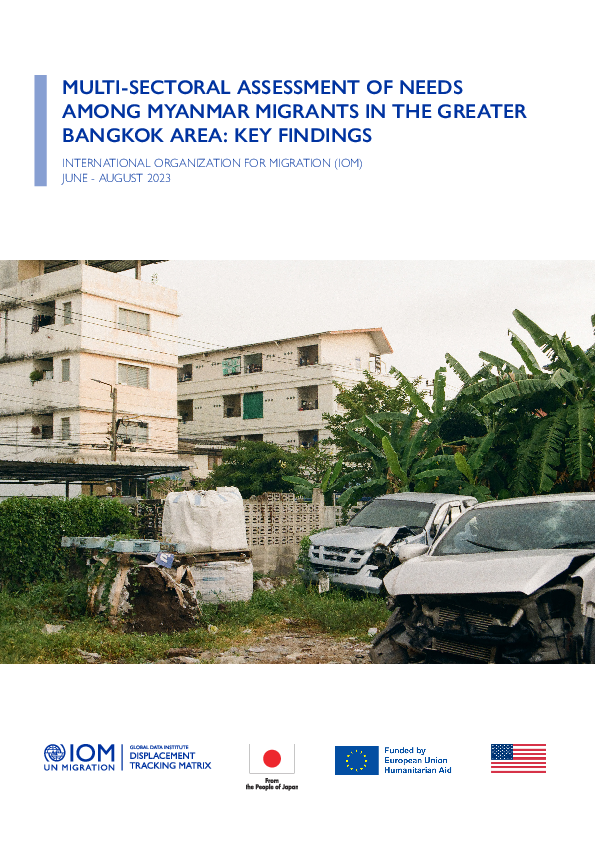
Contact
DTMThailand@iom.int
Language
English
Location
Thailand
Period Covered
Jun 01 2023
Aug 31 2023
Activity
- Survey
- Site Assessment
This report aims to provide details on key findings regarding the multi-sectoral conditions, needs and challenges among the Myanmar migrant population in the Greater Bangkok Area as captured between June to August 2023 by IOM’s Multi-Sectoral Assessment of Needs (MSA). The purpose of this assessment is to provide detailed multi and inter-sectoral analysis of the magnitude and severity of needs among migrant populations, identify vulnerable population groups and geographic areas with the most acute needs, inform development assistance planning and relevant Sustainable Development Goals (SDG) targets, and provide sectoral and inter-sectoral baselines for future assessments. This report includes key findings and related analyses on migration history, economic status, education, employment, health access, and shelter access.
The household survey was answered by 2,260 respondents. The combined number of respondents and their household members is 3,555 individuals.

Contact
DTMUkraine@iom.int
Language
English
Location
Ukraine
Period Covered
Sep 03 2023
Sep 25 2023
Activity
- Survey
Between 3 and 25 September 2023, the International Organization for Migration (IOM) conducted Round 14 of the General Population Survey (GPS), a highly representative assessment of internal displacement in Ukraine which gathers information on population figures, mobility flows, intentions, and conditions to facilitate evidence-based decision-making on strategic, technical, and programmatic aspects of the response and recovery efforts in Ukraine. Further, Round 14 continues to evaluate durable solutions to internal displacement along criteria proposed by the Inter-Agency Standing Committee Framework on Durable Solutions for IDPs (IASC). This report also includes new sections on winterisation and participation in public affairs. The General Population Survey was constructed through interviews with 20,000 respondents using the computer-assisted telephone interview (CATI) method, and a random digit dial (RDD) approach.
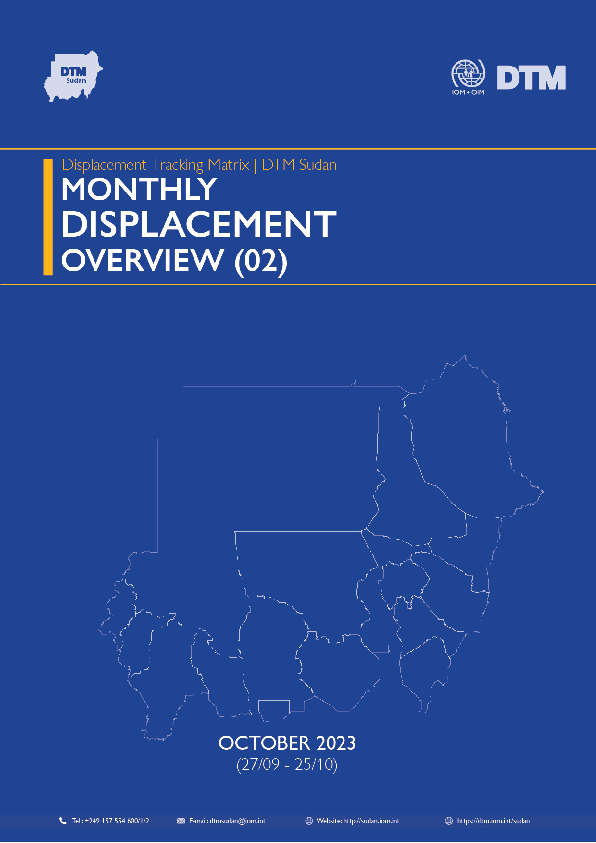
Contact
DTM Sudan, DTMSudan@iom.int
Language
English
Location
Sudan
Snapshot Date
Oct 25 2023
Activity
- Mobility Tracking
- Baseline Assessment
Overview
IOM DTM Sudan is pleased to present its second Monthly Displacement Overview. This publication provides an account of Sudan’s displacement context since 15 April 2023 – outlining population caseloads and movements, as well the present and evolving needs of Sudan’s growing IDP caseload.
Rationale
Recognizing the need for more detailed insights into the IDP situation, including the priority needs, access to services, movement intentions, and demographic breakdowns of the affected population, DTM Sudan has undertaken a comprehensive review of our data collection tool. In collaboration with a wide range of internal and external stakeholders, we have developed a new tool to better inform humanitarian response operations, aligning with the DTM global methodology. Leveraging our extensive network of approximately 300 field-based enumerators and a robust system of over 1500 key informants across the country, DTM has gathered data on IDPs across 5,034 locations, in 168 of Sudan’s 189 localities – across all of Sudan’s 18 states.
Key Findings
- DTM Sudan estimates that 4,856,294 Individuals (967,272 Households) have been recently internally displaced.
- IOM DTM also reports that an estimated 1,304,028 mixed cross-border movements have been made into neighbouring countries.
- Since 15 April 2023, 44% of the IDP caseload has sought refuge in the Darfur and Kordofan regions, whereas the majority (56%) are observed across the Northern, Eastern, and Central states.
- Just over two-thirds of the IDP caseload are seeking shelter with the host community.
- While Food Security remains the highest priority need, Health and Non-Food Items are also growing concerns.

Contact
dtmlebanon@iom.int
Language
English
Location
Lebanon
Period Covered
Oct 10 2023
Jan 11 2023
Activity
- Mobility Tracking
- Baseline Assessment
Since October 8 there has been an increase in cross-border incidents between Israel and Lebanon, resulting in the displacement of people both within the South and elsewhere within the country. Since October 10, the Displacement Tracking Matrix (DTM) has been conducting the daily monitoring of population movements. The objective of the exercise is to inform preparedness and response planning.
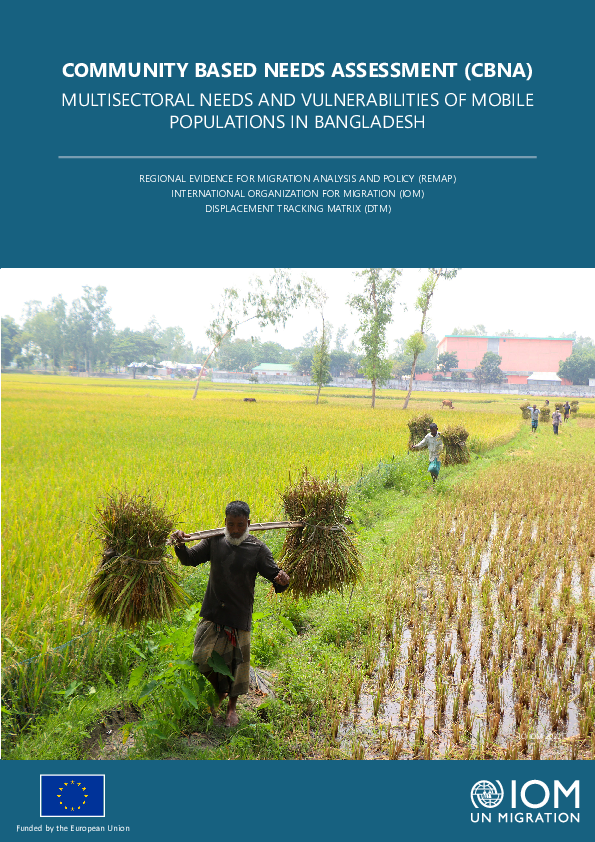
Contact
DTM REMAP Support Team, dtmremapsupport@iom.int; DTM REMAP Bangladesh Team, remapbd@iom.int
Language
English
Location
Bangladesh
Period Covered
Mar 01 2022
Sep 30 2022
Activity
- Mobility Tracking
- Baseline Assessment
This report serves to present the findings from the Community-Based Needs Assessment conducted by DTM between March and September 2022 in Kurigram District, Bangladesh. It focuses on understanding the multisectoral needs and vulnerabilities prevalent in the 2,853 villages across all nine upazilas. The primary objective of CBNA is to furnish a baseline for determining programmatic priorities and enabling geographical targeting of assistance. To achieve this, the assessment supplies summary statistics of essential socio-economic indicators, including employment, household finances and income, food and nutrition, markets, shelter, environmental events (such as flooding and rain), health, education, water, sanitation, and hygiene (WASH), utilities, and received assistance.
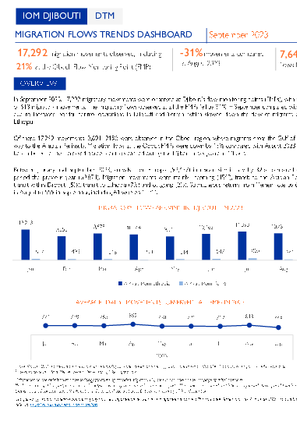
Contact
DTM Djibouti, DTMDjibouti@iom.int
Language
English
Location
Djibouti
Period Covered
Sep 01 2023
Sep 30 2023
Activity
- Flow Monitoring
In September 2023, 17.292 migratory movements were observed at Djibout's flow monitoring points (FMPs), with a daily average of 618 migratory movements. The migratory flows observed at all the FMPs fell by 31% in September compared with August 2023 due to increased border control operations in Djibouti and Yemen, which slowed down the flow of migrants en route from Ethiopia.
Of these 17,292 movements, 3.691 (21%) were observed in the Obock region, where migrants cross the Gulf of Aden on their way to the Arabian Peninsula. Migration flows at the Obock FMPs were down by 15% compared with August 2023. This drop can be attributed to the increased border controls carried out by the Djibouti coastguard in Obock.
Between January and September 2023, arrivals from Ethiopia (92,457) increased significantly by 32% compared with the same period the previous year (69,874). Migration movements were mainly. incoming (45%), transit to the Arabian Peninsula (41%). transit within Djibouti (5%), transit to Ethiopia (7%) and outgoing (2%). Spontaneous returns from Yemen rose by 60%, from 349 in August to 559 in September, including 61 women (11%).
Pagination
- Previous page
- Page 66
- Next page
